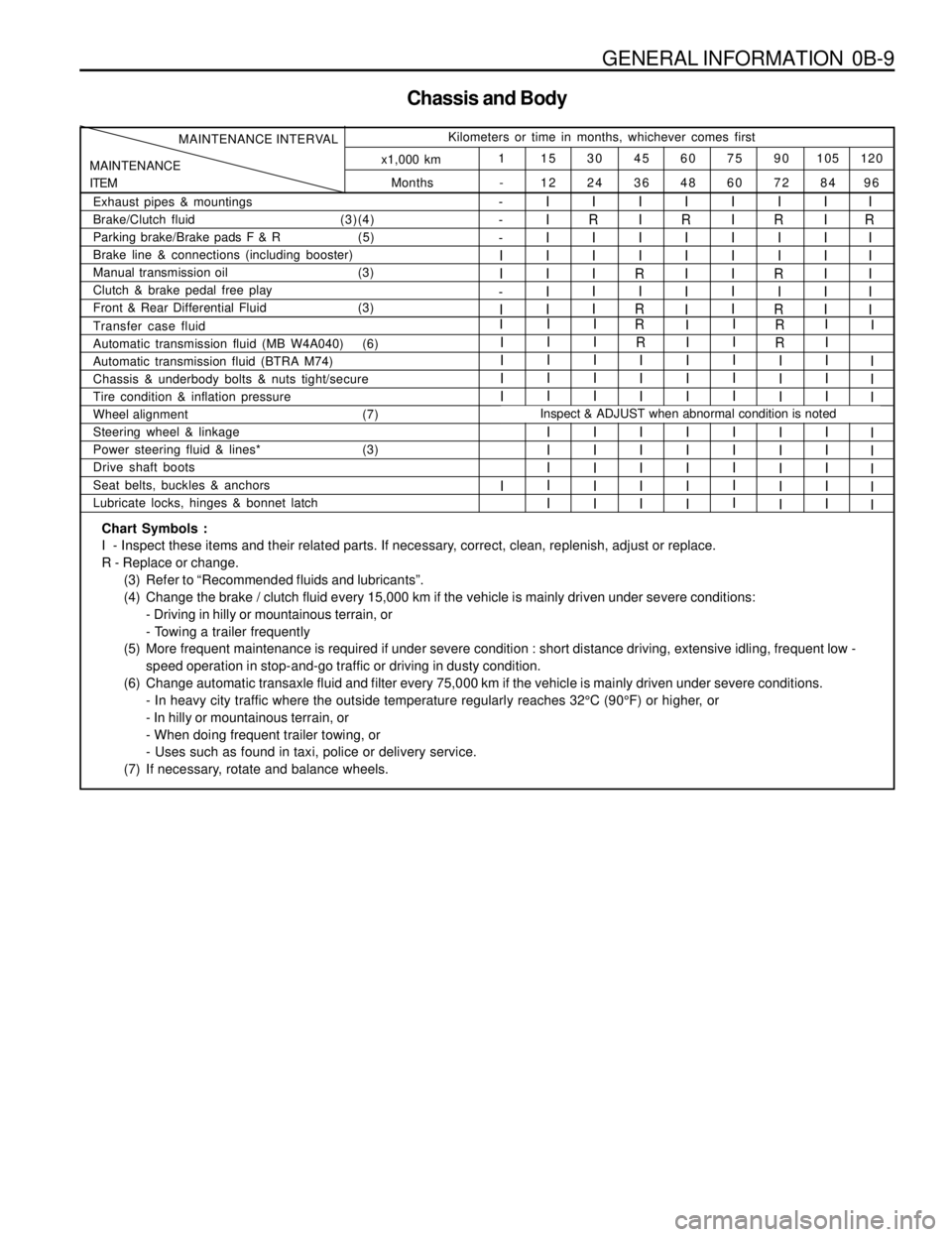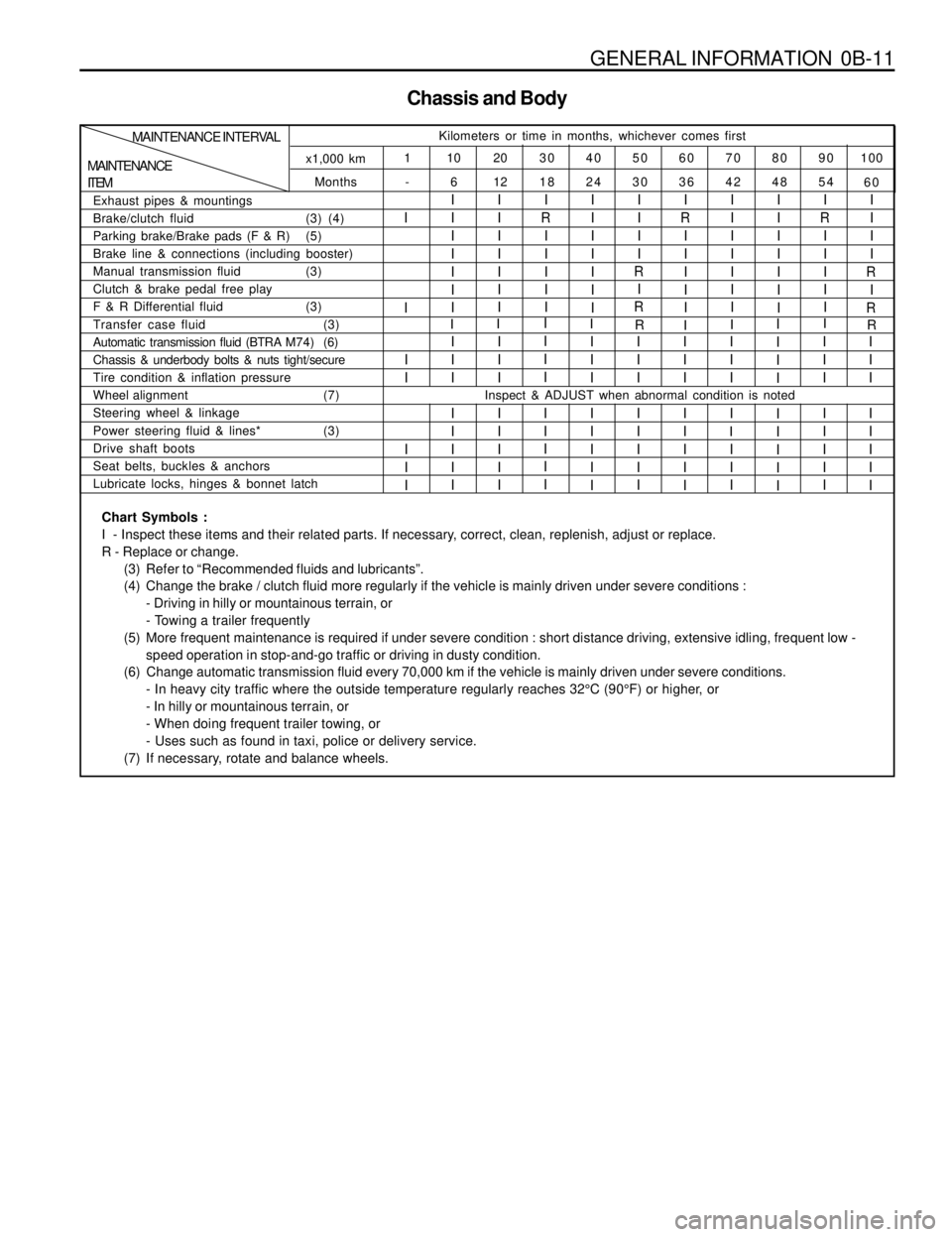wheel alignment SSANGYONG MUSSO 1998 Workshop Repair Manual
[x] Cancel search | Manufacturer: SSANGYONG, Model Year: 1998, Model line: MUSSO, Model: SSANGYONG MUSSO 1998Pages: 1463, PDF Size: 19.88 MB
Page 16 of 1463

0B-4 GENERAL INFORMATION
Specifications
RACK & PINION
0 - 4 mm
2°30’± 30’
0° ± 30’
1L Application
Gear Type
Wheel Alignment:
Front Toe-in
Front Caster
Front Camber
Oil Capacity
Steering System
Application
Front Type
Rear Type
Suspension
Specifications
Double Wishbone
5 - Link
Application
Fuel Pump Type
Fuel Filter Type
Fuel Capacity
Specifications
Electric Motor Pump
Cartridge
70 L
Fuel System
Lubricating Type
Oil Pump Type
Oil Filter Type
Oil Capacity (L) (Including Oil Filter)
Lubricating System
661LA
8.0662NA
9.0662LA
9.52.0L DOHC
7.22.3L DOHC
7.53.2L DOHC
8.2
External Gear pump
Combination(Full & Part)
Full Flow
Cooling Type
Coolant Capacity (L)
Radiator Type
Water Pump Type
Cooling System
661LA
9.5-10662NA
10.5662LA
10.5-112.0L DOHC
10.52.3L DOHC
10.53.2L DOHC
11.3
Forced Circulation
Centrifugal
Application
Battery (MF)
Generator
Starter
Electric System
661LA
75A
2.2kw662NA
75A
2.2kw662LA
75A
2.2kw2.0L DOHC
115A
1.2kw2.3L DOHC
115A
1.2kw3.2L DOHC
115A
1.7kw
12V - 90AH12V - 75AH
Page 19 of 1463

GENERAL INFORMATION 0B-7
MAINTENANCE AND REPAIR
MAINTENANCE AND LUBRICATION
Fuel Filter Replacement
Replace the engine fuel filter every.
lGasoline Engine : 60,000km (36,000 miles)
lDiesel Engine : 45,000km (24,000 miles)
Spark Plug Replacement
Replace spark plugs with same type.
lType : BOSCH : F8DC4
BERU : 14F-8DU4
Champion : C11YCC
lGap : 0.8 ± 0.1 mm
Spark Plug Wire Replacement
Clean wires and inspect them for burns, cracks or other
damage. Check the wire boot fit at the Distributor and at
the spark plugs. Replace the wires as needed.
Brake System Service
Check the disc brake pads or the drum brake linings.
Check the pad and the lining thickness carefully.
Tire and Wheel Inspection and Rotation
Check the tires for abnormal wear or damage. To
equalize wear and obtain maximum tire life, rotate the
tires. If irregular or premature wear exists, check the
wheel alignment and check for damaged wheels. While
the tires and wheels are removed, inspect the brakes.
NORMAL VEHICLE USE
The maintenance instructions contained in the
maintenance schedule are based on the assumption
that the vehicle will be used for the following reasons:
lTo carry passengers and cargo within the limitation
of the tire inflation prassure. Refer to “Tire and Wheel”
in section 2E.
lTo be driven on reasonable road surfaces and within
legal operating limits.
EXPLANATION OF SCHEDULED
MAINTENANCE SERVICES
The services listed in the maintenance schedule are
further explained below. When the following maintenance
services are performed, make sure all the parts are
replaced and all the necessary repairs are done before
driving the vehicle. Always use the proper fluid and
lubricants.
Engine Oil and Oil Filter Change
Always use above the API SH grade or recommended
engine oil.
Engine Oil Viscosity
Engine oil viscosity (thickness) has an effect on fuel
economy and cold weather operation. Lower viscosity
engine oils can provide better fuel economy and cold
weather performance; however, higher temperature
weather conditions require higher viscosity engine oils
for satisfactory lubrication. Using oils of any viscosity
other than those viscosities recommended could result
in engine damage.
Cooling System Service
Drain, flush and refill the system with new coolant. Refer
to “Recommended Fluids And Lubricants” in this section.
Air Cleaner Element Replacement
Clean the air cleaner element every.
lGasoline Engine : 15,000km (10,000 miles)
lDiesel Engine : 10,000km (6,000 miles)
Replace the air cleaner element every .
lGasoline Engine : 60,000km (36,000 miles)
lDiesel Engine : 30,000km (18,000 miles)
Replace the air cleaner more often under dusty
conditions.
Tire Rotation (Left - Hand Drive Type)
Page 21 of 1463

GENERAL INFORMATION 0B-9
Chassis and Body
Months
MAINTENANCE
ITEMMAINTENANCE INTERVALKilometers or time in months, whichever comes first
120 105 90 75 60 45 30 15 1
96 84 72 60 48 36 24 12
- x1,000 km
Exhaust pipes & mountings
Brake/Clutch fluid(3)(4)
Parking brake/Brake pads F & R (5)
Brake line & connections (including booster)
Manual transmission oil (3)
Clutch & brake pedal free play
Front & Rear Differential Fluid (3)I
R
I
I
I
I
I-
-
-
I
I
-
II
I
I
I
I
I
II
R
I
I
I
I
II
I
I
I
R
I
RI
I
I
I
I
I
II
R
I
I
R
I
RI
I
I
I
I
I
II
R
I
I
I
I
I
Automatic transmission fluid (MB W4A040) (6)
Automatic transmission fluid (BTRA M74)
Chassis & underbody bolts & nuts tight/secure
Tire condition & inflation pressure
Wheel alignment (7)
Steering wheel & linkage
Power steering fluid & lines* (3)
Drive shaft boots
Seat belts, buckles & anchors
Lubricate locks, hinges & bonnet latchI
I
I
I
II
I
I
I
I
I
I
I
I
II
I
I
I
I
I
I
I
I
IR
I
I
I
I
I
I
I
II
I
I
I
I
I
I
I
II
I
I
I
I
I
I
I
I
IR
R
I
I
I
I
I
I
I
II
I
I
I
I
I
I
I
I
Transfer case fluidRIII
Inspect & ADJUST when abnormal condition is noted
I
I
I
I
I
I
I
I
I
Chart Symbols :
I - Inspect these items and their related parts. If necessary, correct, clean, replenish, adjust or replace.
R - Replace or change.
(3) Refer to “Recommended fluids and lubricants”.
(4) Change the brake / clutch fluid every 15,000 km if the vehicle is mainly driven under severe conditions:
- Driving in hilly or mountainous terrain, or
- Towing a trailer frequently
(5) More frequent maintenance is required if under severe condition : short distance driving, extensive idling, frequent low -
speed operation in stop-and-go traffic or driving in dusty condition.
(6) Change automatic transaxle fluid and filter every 75,000 km if the vehicle is mainly driven under severe conditions.
- In heavy city traffic where the outside temperature regularly reaches 32°C (90°F) or higher, or
- In hilly or mountainous terrain, or
- When doing frequent trailer towing, or
- Uses such as found in taxi, police or delivery service.
(7) If necessary, rotate and balance wheels.
Page 23 of 1463

GENERAL INFORMATION 0B-11
Chassis and Body
Months
-
MAINTENANCE
ITEMMAINTENANCE INTERVAL
Kilometers or time in months, whichever comes first
100 90 80 70 60 50 40 30 20 10 1
60 54 48 42 36 30 24 18 12 6 x1,000 km
Exhaust pipes & mountings
Brake/clutch fluid(3) (4)
Parking brake/Brake pads (F & R) (5)
Brake line & connections (including booster)
Manual transmission fluid (3)
Clutch & brake pedal free play
F & R Differential fluid (3)
I
II
I
I
I
I
I
II
I
I
I
I
I
II
R
I
I
I
I
II
I
I
I
I
I
II
I
I
I
R
I
RI
R
I
I
I
I
II
I
I
I
I
I
II
I
I
I
I
I
II
R
I
I
I
I
II
I
I
I
R
I
R
Automatic transmission fluid (BTRA M74) (6)
Chassis & underbody bolts & nuts tight/secure
Tire condition & inflation pressure
Wheel alignment (7)
Steering wheel & linkage
Power steering fluid & lines* (3)
Drive shaft boots
Seat belts, buckles & anchors
Lubricate locks, hinges & bonnet latchI
I
I
I
I
I
I
II
I
I
I
I
I
I
II
I
I
I
I
I
I
I
II
I
I
I
I
I
I
II
I
I
I
I
I
I
II
I
I
I
I
I
I
II
I
I
I
I
I
II
I
I
I
I
I
I
II
I
I
I
I
I
I
I
Transfer case fluid (3)R
IR
I II
I
I
I
I
II
I
I
I
I
I
I
I
I
Inspect & ADJUST when abnormal condition is noted
II
I
Chart Symbols :
I - Inspect these items and their related parts. If necessary, correct, clean, replenish, adjust or replace.
R - Replace or change.
(3) Refer to “Recommended fluids and lubricants”.
(4) Change the brake / clutch fluid more regularly if the vehicle is mainly driven under severe conditions :
- Driving in hilly or mountainous terrain, or
- Towing a trailer frequently
(5) More frequent maintenance is required if under severe condition : short distance driving, extensive idling, frequent low -
speed operation in stop-and-go traffic or driving in dusty condition.
(6) Change automatic transmission fluid every 70,000 km if the vehicle is mainly driven under severe conditions.
- In heavy city traffic where the outside temperature regularly reaches 32°C (90°F) or higher, or
- In hilly or mountainous terrain, or
- When doing frequent trailer towing, or
- Uses such as found in taxi, police or delivery service.
(7) If necessary, rotate and balance wheels.
Page 24 of 1463

0B-12 GENERAL INFORMATION
OWNER INSPECTIONS
AND SERVICES
WHILE OPERATING THE VEHICLE
Horn Operation
Blow the horn occasionally to make sure it works. Check
all the button locations.
Brake System Operation
Be alert for abnormal sounds, increased brake pedal
travel or repeated puling to one side when braking. Also,
if the brake warning light goes on, or flashes, something
may be wrong with part of the brake system.
Exhaust System Operation
Be alert to any changes in the sound of the system or
the smell of the fumes. These are signs that the system
may be leaking or overheating. Have the system
inspected and repaired immediately.
Tires, Wheels and Alignment Operation
Be alert to any vibration of the steering wheel or the
seats at normal highway speeds. This may mean a wheel
needs to be balanced. Also, a pull right or left on a
straight, level road may show the need for a tire pressure
adjustment or a wheel alignment.
Steering System Operation
Be alert to changes in the steering action. An inspection
is needed when the steering wheel is hard to turn or
has too much free play, or is unusual sounds are noticed
when turning or parking.
Headlight Aim
Take note of the light pattern occasionally. Adjust the
headlights if the beams seem improperly aimed.
AT EACH FUEL FILL
A fluid loss in any (except windshield washer) system
may indicate a problem. Have the system inspected and
repaired immediately.
Engine Oil Level
Check the oil level and add oil if necessary. The best
time to check the engine oil level is when the oil is warm.
1. After stopping the engine, wait a few minutes for the
oil to drain back to the oil pan.
2. Pull out the oil level indicator (dip stick).
3. Wipe it clean, and push the oil level indicator back
down all the way.
4. Pull out the oil level indicator and look at the oil level
on it.5. Add oil, if needed, to keep the oil level above the
lower mark. Avoid overfilling the engine, since this
may cause engine damage.
6. Push the indicator all the way back down into the
engine after taking the reading.
If you check the oil level when the oil is cold, do not run
the engine first. The cold oil will not drain back to the
pan fast enough to give a true oil level reading.
Engine Coolant Level and Condition
Check the coolant level in the coolant reservoir tank
and add coolant if necessary. Inspect the coolant.
Replace dirty or rusty coolant.
Windshield Washer Fluid Level
Check the washer fluid level in the reservoir. Add fluid if
necessary.
AT LEAST TWICE A MONTH
Tire And Wheel Inspection and Pressure
Check
Check the tire for abnormal wear or damage. Also check
for damaged wheels. Check the tire pressure when the
tires are cold ( check the spare also, unless it is a
stowaway). Maintain the recommended pressures. Refer
to “Tire and Wheel” is in section 0B.
AT LEAST MONTHLY
Light Operation
Check the operation of the license plate light, the
headlights (including the high beams), the parking lights,
the fog lights, the taillight, the brake lights, the turn
signals, the backup lights and the hazard warning flasher.
Fluid Leak Check
Periodically inspect the surface beneath the vehicle for
water, oil, fuel or other fluids, after the vehicle has been
parked for a while. Water dripping from the air
conditioning system after use is normal. If you notice
fuel leaks or fumes, find the cause and correct it at once.
AT LEAST TWICE A YEAR
Power Steering System Reservoir Level
Check the power steering fluid level. Keep the power
steering fluid at the proper level. Refer to
Section 6A,
Power Steering System.
Brake Master Cylinder Reservoir Level
Check the fluid and keep it at the proper level. A low
fluid level can indicate worn disc brake pads which may
need to be serviced. Check the breather hole in the
reservoir cover to be free from dirt and check for an
open passage.
Page 303 of 1463

SECTION 1B3
OM600 ENGINE MECHANICAL
CAUTION: Disconnect the negative battery cable before removing or installing any electrical unit or when a
tool or equipment could easily come in contact with exposed electrical terminals. Disconnecting this cable
will help prevent personal injury and damage to the vehicle. The ignition must also be in LOCK unless otherwise
noted.
Specifications . . . . . . . . . . . . . . . . . . . . . . . 1B3-2
Fastener Tightening Specifications . . . . . . . . 1B3-2
Special Tools . . . . . . . . . . . . . . . . . . . . . . . 1B3-4
Special Tools Table . . . . . . . . . . . . . . . . . . . . 1B3-4
Maintenance and Repair . . . . . . . . . . . . . 1B3-12
On-Vehicle Service . . . . . . . . . . . . . . . . . . . . 1B3-12
Engine Assembly . . . . . . . . . . . . . . . . . . . . 1B3-12
Poly V-Belt . . . . . . . . . . . . . . . . . . . . . . . . . 1B3-21
Tensioning Device . . . . . . . . . . . . . . . . . . . . 1B3-23
Poly V-Belt Alignment & Inspection . . . . . . . 1B3-26
Prechamber . . . . . . . . . . . . . . . . . . . . . . . . 1B3-29
Milling of Prechamber Sealing Surface . . . . 1B3-32
TDC (TDC Sensor Bracket) Setting . . . . . . 1B3-35
Cylinder Head . . . . . . . . . . . . . . . . . . . . . . . 1B3-37
Timing Case Cover . . . . . . . . . . . . . . . . . . . 1B3-63
Crankshaft End Cover . . . . . . . . . . . . . . . . 1B3-71
Vibration Damper and Hub . . . . . . . . . . . . . 1B3-74
Crankshaft Front Radial Seal . . . . . . . . . . . 1B3-80
Crankshaft Ball Bearing . . . . . . . . . . . . . . . 1B3-82
Crankshaft . . . . . . . . . . . . . . . . . . . . . . . . . 1B3-83
Flywheel . . . . . . . . . . . . . . . . . . . . . . . . . . . 1B3-93
Machining of Flywheel . . . . . . . . . . . . . . . . 1B3-97
Flywheel Ring Gear . . . . . . . . . . . . . . . . . . 1B3-98
Hydraulic Valve Clearance Compensation
Element Check . . . . . . . . . . . . . . . . . . . . 1B3-101
Valve Tappets . . . . . . . . . . . . . . . . . . . . . . 1B3-103
Valve Spring Check . . . . . . . . . . . . . . . . . 1B3-105
Valve Springs (Cylinder Head Removed) . 1B3-106
TABLE OF CONTENTS
Valve Springs (Cylinder Head Installed) . . 1B3-109
Valve Stem Seals . . . . . . . . . . . . . . . . . . . 1B3-112
Check and Replacement of
Valve Guides . . . . . . . . . . . . . . . . . . . . . 1B3-116
Valve Seat Rings . . . . . . . . . . . . . . . . . . . 1B3-122
Check and Machining of Valves . . . . . . . . 1B3-127
Machining of Valve Seat . . . . . . . . . . . . . . 1B3-132
Camshaft Timing Test . . . . . . . . . . . . . . . . 1B3-137
Camshaft . . . . . . . . . . . . . . . . . . . . . . . . . 1B3-139
Chain Tensioner . . . . . . . . . . . . . . . . . . . . 1B3-145
Timing Chain . . . . . . . . . . . . . . . . . . . . . . . 1B3-147
Tensioning Rail . . . . . . . . . . . . . . . . . . . . . 1B3-151
Cylinder Head Guide Rail . . . . . . . . . . . . . 1B3-152
Timing Case Cover Guide Rail . . . . . . . . . 1B3-156
Crankshaft Sprocket . . . . . . . . . . . . . . . . . 1B3-158
Piston . . . . . . . . . . . . . . . . . . . . . . . . . . . . 1B3-163
Oil Filter . . . . . . . . . . . . . . . . . . . . . . . . . . 1B3-169
Oil Pan . . . . . . . . . . . . . . . . . . . . . . . . . . . 1B3-171
Oil Spray Nozzle . . . . . . . . . . . . . . . . . . . . 1B3-174
Oil Pump . . . . . . . . . . . . . . . . . . . . . . . . . . 1B3-175
Unit Repair . . . . . . . . . . . . . . . . . . . . . . . 1B3-177
Cylinder Head Pressure Leakage Test . . . 1B3-177
Facing Cylinder Head Mating Surface . . . . 1B3-178
Replacement of Crankcase Core Plug . . . 1B3-180
Facing Crankcase Contacting Surface . . . 1B3-182
Oil Gallery Steel Ball . . . . . . . . . . . . . . . . . 1B3-183
Cylinder Bore Measurement . . . . . . . . . . . 1B3-187
Page 348 of 1463

1B3-46 OM600 ENGINE MECHANICAL
30. Rotate the crankshaft and set the no.1 cylinder at TDC.
Notice
Do not rotate the crankshaft to the opposite direction of
engine revolution.
31. Place alignment marks on the camshaft gear and timing
chain.
32. Ensure that the camshaft and the bearing cap marking
are aligned.
33. Remove the starter motor and install the engine lock onto
the flywheel ring gear.
Engine Lock 602 589 00 40 00
Page 378 of 1463

1B3-76 OM600 ENGINE MECHANICAL
Removal Procedure
1. Remove the starter motor and install the engine lock into
the wheel ring gear.
Engine Lock 602 589 00 40 00
2. Remove the poly V-belt.
3. Remove the cooling fan.
Notice
Keep the fan in vertical position.
4. Remove the cooling fan belt pulley (2).
5. Place alignment marks (arrow) on the vibration damper (5)
and crankshaft belt pulley (4).
6. Remove the timing sensor bracket.
Notice
Remove if necessary.
Page 818 of 1463

SUSPENSION DIAGNOSIS 2A-3
DIAGNOSIS
GENERAL DIAGNOSIS
Checks
Loosened Mountings
Damaged or Worn wheel Bearing
Damaged Shock Absorber
Damaged TireAction
Retightening
Replace
Replace
Replace
Abnormal Noises
Checks
Broken Stabilizer Bar
Faulty Shock AbsorberAction
Replace
Replace
Vehicle Rolling
Checks
Over Inflated Tire
Faulty Shock Absorber
Loosened wheel Nut
Bent or Broken Coil Spring
Damaged Tire
Worn BushingAction
Pressure Adjustment
Replace
Tighten as Specified
Replace
Replace
Replace
Poor Riding
Problems in the steering, the suspension, the tires, and
the wheels involve several systems. Consider all systems
when you diagnose a complaint. Some problems, such
as abnormal or excessive tire wear and scuffed tires,
may by the result of hard driving. Always road test thevehicle first. If possible, do this road test with the
customer.
Proceed with the following preliminary checks. Correct
any substandard conditions.
Checks
Incorrect Wheel Alignment
Excessive Resistance of Lower Arm Ball Joint
Insufficient Tire Pressure
Faulty Power Steering
Action
Repair
Replace
Adjust
Repair or Replace
Hard Steering
Checks
Deformed Arm Assembly
Worn Bushing
Bent or Broken Coil Spring
Difference Between L/H & R/H HeightsAction
Replace
Replace
Replace
Adjust
Vehicle Pulls to Right or Left
Page 819 of 1463

2A-4 SUSPENSION DIAGNOSIS
Checks
Worn or Broken Coil SpringChecks
Incorrect Front wheel Alignment
Worn or Loosened Lower Arm Bushing
Action
Replace
Repair or Replace
Steering Instability
Action
Replace
Vehicle Bottoming